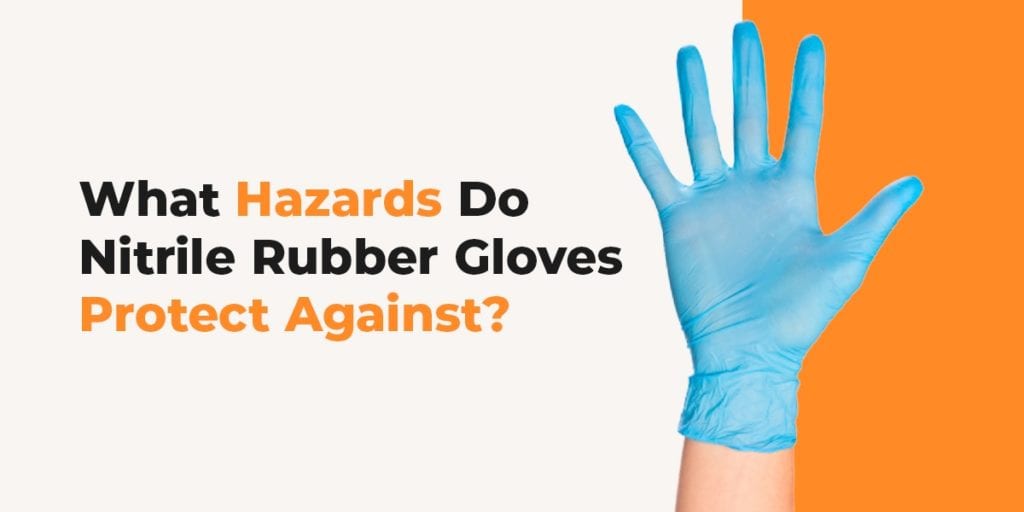
What Hazards Do Nitrile Rubber Gloves Protect Against?
Disposable gloves are an essential piece of personal protective equipment (PPE), which means choosing the right disposable glove for your workplace is a paramount decision. Healthcare workers, in particular, need reliable disposable gloves that will keep them safe from hazards such as chemicals, biological materials, sharp objects and more. Nitrile gloves are a viable option for the healthcare industry because they are protective, durable, easy to change, affordable and latex-free.
To help you make an informed PPE choice, this article will cover what nitrile gloves are, what they are used for, what hazards nitrile gloves do and do not protect against and how to choose the right disposable glove for your application. Regardless of which type of healthcare setting you work in, this article will help you determine the best PPE for you.
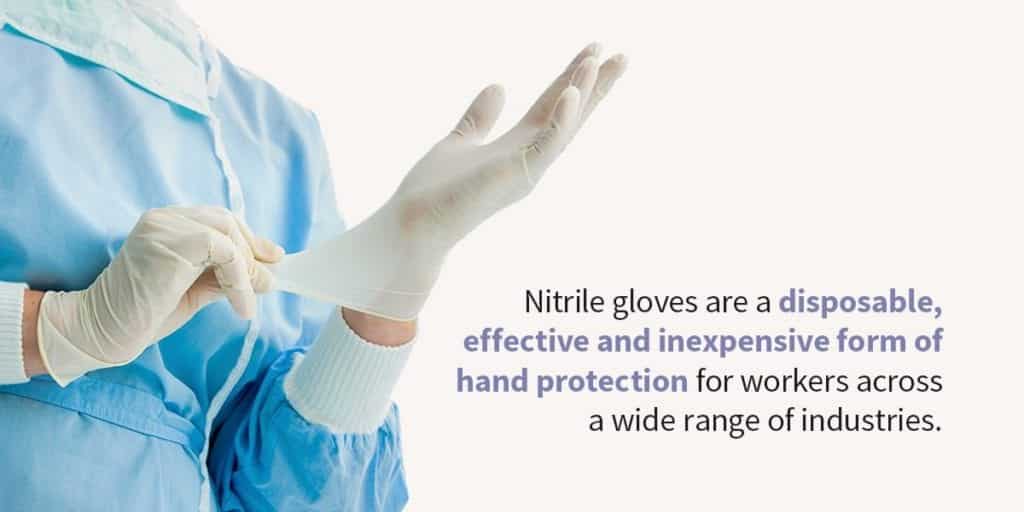
What Are Nitrile Gloves?
Nitrile gloves are a disposable, effective and inexpensive form of hand protection for workers across a wide range of industries. The word nitrile is short for acrylonitrile-butadiene rubber. Unlike latex gloves, which are made with natural rubber, nitrile rubber gloves are synthetic and latex-free. This means nitrile gloves are a dependable PPE alternative for anyone with a latex allergy.
To produce these synthetic rubber gloves, the rubber from rubber trees must first be transformed into latex rubber before being reprocessed. Once the rubber has been manufactured into latex, the monomers acrylonitrile and butadiene are bonded together to form the nitrile compound material. This extra step of processing removes all latex proteins, making nitrile gloves reliably latex-free.
The resulting nitrile gloves are durable as well as resistant to both punctures and chemicals. While manufacturing disposable nitrile rubber gloves used to be an expensive process, modern technological advancements have led to a more cost-effective approach. Nitrile gloves are now equally as affordable as regular latex gloves. Due to the affordability, accessibility and low allergy rating of nitrile gloves, many people choose them over latex gloves.
Nitrile rubber gloves are available in a variety of colors, thicknesses and sizes, making them suitable for an array of applications. Nitrile gloves are also unisex and ambidextrous so workers don’t have to waste time finding matching sets, and workplaces don’t need to worry about keeping numerous styles in stock.
What Are Nitrile Gloves Used For?
Nitrile gloves are suitable PPE for applications in a variety of industries. The disposable gloves give the wearer dependable hand protection from a range of potential hazards, including cuts, liquids and abrasive materials.
The comfortable fit of nitrile gloves and the ease of putting them on and removing them also make them a valuable asset for industries that necessitate extended PPE use. Nitrile gloves are also suitable for applications or jobs that are shorter in duration and require frequent glove changes.
Specifically, nitrile gloves can assist workers within these environments:
- Medical facilities: Nitrile gloves are commonly used for medical purposes because they provide a two-way contact barrier whenever a medical professional is evaluating a patient, handling biological materials or disposing of medical waste. From examinations and surgery to dentistry and pharmaceuticals, nitrile gloves offer healthcare workers across a variety of specialties reliable hand protection. The FDA recommends that workers in hospitals and other healthcare facilities wear nitrile gloves to ensure adequate protection.
- Chemical labs: Those who regularly perform laboratory work often come in contact with potentially harmful substances. The chemical resistance of nitrile gloves makes them a viable solution for protecting these workers from dangerous materials such as hazardous chemicals and organic solvents.
- Industrial plants: Wearing nitrile gloves can provide protection from hazards such as commercial cleaning products, chemicals, pesticides and more, making them highly suitable for industrial and commercial settings. Those working in manufacturing, automotive or janitorial roles also rely on nitrile gloves for the dexterity they afford.
- Foodservice: Nitrile gloves are safe for food handling and can offer the wearer extra protection during food prep. The ease of changing nitrile gloves also makes them perfect for those in a customer-facing role, which often requires frequent glove changes. Additionally, using a color-coded system of nitrile gloves can help a food-based business prevent cross-contamination.
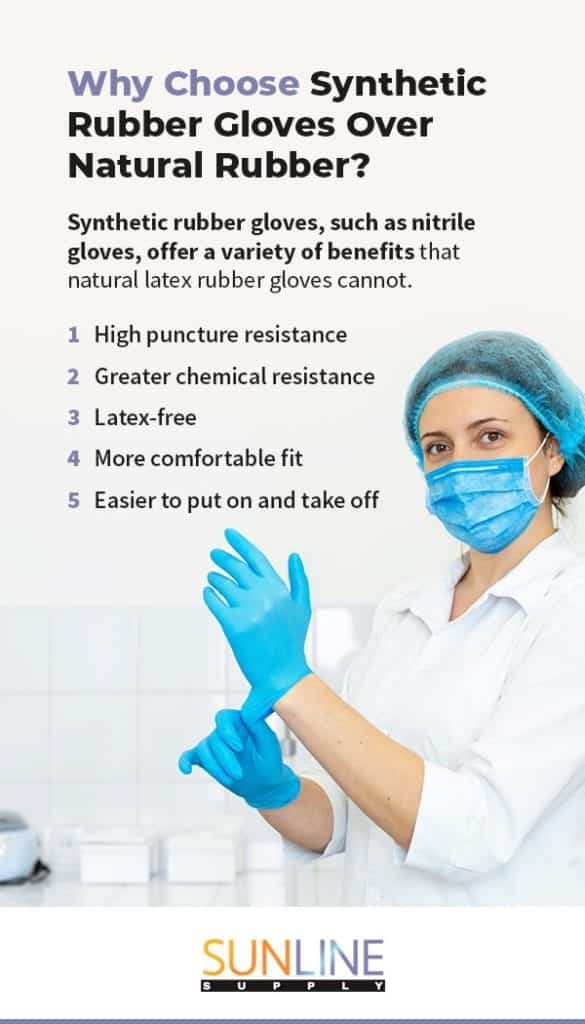
Why Choose Synthetic Rubber Gloves Over Natural Rubber?
Synthetic rubber gloves, such as nitrile gloves, offer a variety of benefits that natural latex rubber gloves cannot. Below are the top five advantages to choosing nitrile rubber gloves instead of latex gloves.
- High puncture resistance: The resistance of nitrile gloves to punctures and tears makes them more durable than latex gloves. Puncture-resistance is essential for PPE because a hole in a disposable rubber glove could expose the wearer to concerning environmental contaminants.
- Greater chemical resistance: Along with more puncture resistance, nitrile gloves offer more chemical resistance than latex gloves. Nitrile gloves can help keep the wearer safe from chemicals, acids and oils by serving as a strong barrier of protection.
- Latex-free: Unlike natural rubber gloves, nitrile gloves are latex-free and suitable for anyone with a latex allergy or sensitive skin. Latex-free gloves are particularly favored in medical settings in which healthcare professionals must be considerate of patients who may have a latex allergy. Exclusively wearing hypoallergenic gloves can help healthcare workers avoid accidentally causing an allergic reaction in a patient.
- More comfortable fit: As body heat warms nitrile gloves, the nitrile rubber conforms better to the shape of the human hand, allowing for a more snug and comfortable fit than latex gloves. This more natural fit gives the wearer greater dexterity to complete tasks efficiently as well as comfort to keep the gloves on for extended amounts of time.
- Easier to put on and take off: Nitrile rubber gloves have a lower resistance to friction than natural rubber latex gloves, which makes nitrile gloves easier to don and doff. During the manufacturing process for nitrile gloves, finishes are applied to make putting on and removing the disposable gloves go more smoothly. This finish means using powder to help the gloves slide on isn’t necessary with nitrile gloves, eliminating the chance of creating a mess of powdery residue.
Are Nitrile Gloves Chemical Resistant?
Synthetic nitrile rubber boasts a short-term splash resistance and chemical degradation resistance against a variety of substances, which is what makes it such a dependable material for general-duty gloves. Nitrile gloves also provide wearers with an ample breakthrough time, which refers to the time elapsed between the initial contact of the glove surface with the chemical and the chemical becoming detectable on the inside of the glove.
Although nitrile gloves can protect against numerous chemicals, they are not resistant to all substances. Make sure nitrile gloves are suitable for the substances that you anticipate them coming into contact with before purchasing them.
Most notably, nitrile gloves provide adequate protection from these common chemicals:
- Acetone
- Ethanol
- Isobutyl
- Isopropyl
- Methanol
Are Nitrile Gloves Impermeable?
No matter how durable a disposable rubber glove is, nothing is impermeable forever. Eventually, some chemicals are able to pass through nitrile gloves. However, the permeation rate of nitrile gloves is better than many other rubber glove varieties, such as latex gloves.
In general, a permeation resistance test measures the rate at which different chemicals can pass through a material on a molecular level. A glove’s permeation rate refers to the rate at which a chemical can pass through its material by absorbing into the glove’s surface, diffusing through the material and desorbing onto the glove’s inner surface.
Nitrile gloves offer more protection than latex gloves because the lower permeation rate of nitrile gloves indicates that they can resist chemicals for a longer period. A higher permeation rate grants a nitrile glove wearer a bit more time to safely change their gloves after being exposed to a harmful chemical before the chemical comes into contact with their skin.
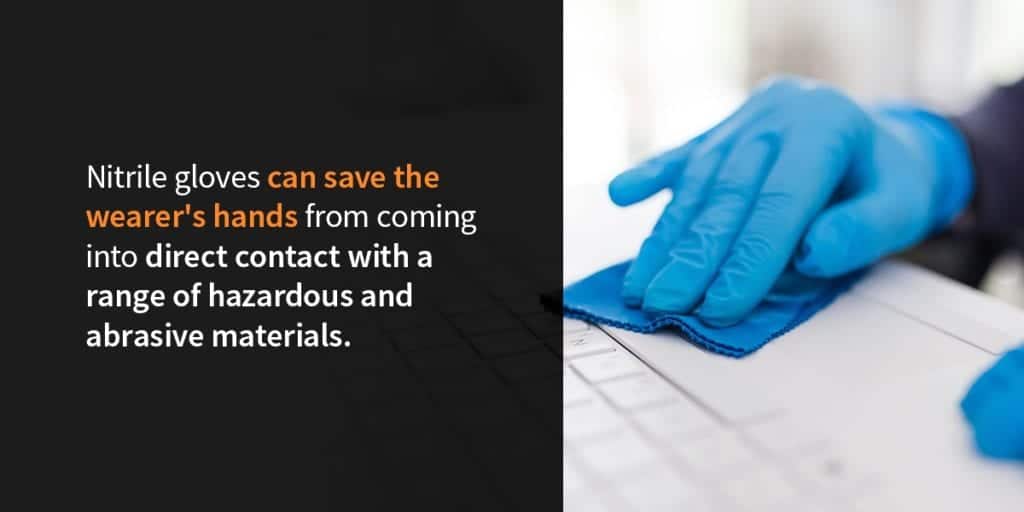
What Do Nitrile Gloves Protect Against?
Wearing the appropriate glove can guard workers’ hands against skin irritations, infections, burns, cuts and abrasions. Nitrile gloves can save the wearer’s hands from coming into direct contact with a range of hazardous and abrasive materials. In addition to protecting the wearer, nitrile gloves can protect any delicate materials being handled, such as electronics, metal and glass.
Before discussing the specifics of what substances nitrile gloves protect against, it is important to differentiate incidental contact and extended contact. Use these definitions to distinguish between incidental and extended contact scenarios:
- Incidental contact: Situations that involve minimal contact with hazardous material, such as accidental splashes or spills, unintentional overspray from a dispensing machine and dealing with infectious agents that necessitate barrier protection. In these cases, a barrier between the glove wearer and the material is all that is needed to avoid incidental contact.
- Extended contact: Situations that involve more long-term exposure, such as encountering highly contaminated materials, the submergence of hands into a chemical or another hazardous substance, undergoing extreme temperatures and handling sharp or piercing objects.
The exact ability of a nitrile glove to provide protection from a substance depends on the glove’s thickness. Thinner nitrile gloves, such as a disposable exam glove, are intended for incidental contact, whereas thicker nitrile gloves, such as thicker reusable gloves, are suitable for extended contact. In general, disposable nitrile gloves that are at least 5 millimeters thick can fend off breakthrough for 15 minutes after coming in contact with many chemicals.
Specifically, nitrile rubber gloves offer this reliable splash protection from the following substances:
- Micro-organisms: Nitrile gloves offer protection against many types of micro-organisms, including bacteria, fungi and viruses. Due to this dependable protection, nitrile rubber makes great surgical-grade medical gloves.
- Oils, fuels and petroleum products: Nitrile gloves serve as a barrier between the wearer’s hands and potentially dangerous petroleum products, such as oils, fuels and greases. This high level of protection makes nitrile gloves a popular choice for automotive, manufacturing and industrial use.
- Weak acids: Nitrile gloves can protect wearers from weak acids, such as sulfuric acid and nitric acid. This resistance makes nitrile gloves versatile and practical for a variety of industries from pharmaceuticals to foodservice.
- Weak caustics: The term caustic refers to any substance that has the potential to cause corrosion. Nitrile gloves can resist mildly caustic substances.
- Some organic solvents: The resistance of nitrile lab gloves to many organic solvents make them suitable for use in laboratory work and various experiments.
What Shouldn’t Nitrile Gloves Be Used Against?
Although nitrile gloves offer sufficient protection from a vast variety of chemicals and hazardous materials, there are some severe substances that nitrile gloves should not be used to handle. When put in contact with extremely hazardous substances, nitrile gloves offer poor resistance, providing less than a minute breakthrough time. If the toxic material seeps through the glove, it could cause skin damage to the wearer’s hand.
To avoid potential health issues, do not wear nitrile gloves when working with these potentially dangerous materials:
- Aromatic solvents
- Ketones
- Acetates
- Concentrated acids
- Highly corrosive chemicals
Instead of wearing nitrile gloves to handle exceptionally hazardous materials, opt for one of these protective glove varieties:
- Butyl: Butyl rubber boasts the highest resistance to gas and water vapors, which makes them especially useful when handling ketones and esters. However, butyl rubber gloves will not offer protection against hydrocarbons or chlorinated solvents.
- Norfoil: Norfoil is a suitable material for working with most hazardous chemicals but does not offer a great fit or much dexterity for the wearer.
- Viton: Viton gloves are specifically designed for chemical resistance. While these gloves boast excellent resistance to aromatic and chlorinated solvents, they provide little protection against abrasions and cuts.
- Neoprene: Neoprene gloves are suitable for working with more moderate acids and caustics as well as dealing with extreme heat. However, neoprene is also more susceptible to tears.
How to Dispose of Nitrile Gloves After Contamination
If your nitrile gloves do happen to become contaminated when you are wearing them, it is imperative that you follow the proper contaminated glove disposal procedures, as outlined by the Centers for Disease Control and Prevention (CDC). Using the correct glove doffing technique will help prevent cross-contamination.
Once your gloves become contaminated, follow these steps:
- Grasp the outside of one glove at the wrist, being careful not to touch your skin.
- Peel the glove away from your body, pulling it inside out.
- Hold the freshly removed glove in the still-gloved hand.
- Slide your non-gloved fingers into the glove you still have on at the top of the wrist to start peeling it off.
- Turn the second glove inside out as you pull it away from your body, leaving the first glove inside the second.
- Safely dispose of the gloves, ensuring they never get reused.
- Clean your hands immediately after removing the contaminated gloves.
How to Choose the Right Type of Disposable Glove
Selecting the right type of disposable glove for your workplace depends on identifying the hazardous substances you are most likely to encounter. You will need a disposable glove that delivers adequate protection from these materials while providing the flexibility and comfort you need to perform your task well, all for a good value.
The first step in deciding which disposable glove is right for you is to determine the hazards you will need protection from. Consider the following factors:
- Types of chemicals: The more corrosive the chemicals you’re working with are, the higher the level of chemical-resistance and chemical degradation-resistance your gloves need to have.
- Temperature extremes: For extreme temperatures, make sure your gloves offer heat and flame protection.
- Physical hazards, such as sharps or piercing objects: When dealing with physical hazards, you need gloves with cut resistance and puncture resistance.
- Toxicity: Choose gloves with a low permeation rate for handling toxic materials.
- The infectious potential of biological materials: Wearing thicker gloves to manipulate biological materials can minimize your risk of infection.
Next, you will need to determine whether you will have incidental or extended contact with the materials. Disposable, surgical-type gloves are ideal for incidental contact applications. Nitrile gloves are preferable to latex gloves because they have a higher chemical resistance and a lower tendency to rip when punctured. Additionally, wearing nitrile gloves accommodates any potential latex allergies.
On the other hand, extended use situations call for more substantial gloves. When working with highly toxic materials or substances that may be absorbed through the skin, wear a thicker glove, such as norfoil gloves. Placing a tight nitrile glove over a norfoil glove can help the wearer regain some dexterity.
Shop for Bulk Nitrile Gloves From SUNLINE Supply
If your organization needs nitrile gloves in bulk, order non-toxic, high-quality nitrile gloves from SUNLINE Supply. At SUNLINE Supply, we only source our inventory from reliable vendors to ensure our nitrile gloves are of the highest quality. They offer premium protection along with superior touch sensitivity and grip due to their micro-roughened surfaces.
You can order your bulk nitrile medical gloves in a variety of sizes, including small, medium, large and extra-large. We keep our PPE stocked and ready to ship so you can receive your nitrile gloves promptly. We also offer rapid production and order fulfillment services to fill orders of any volume and size as quickly and reliably as possible.
To order your bulk nitrile gloves, contact SUNLINE Supply today.
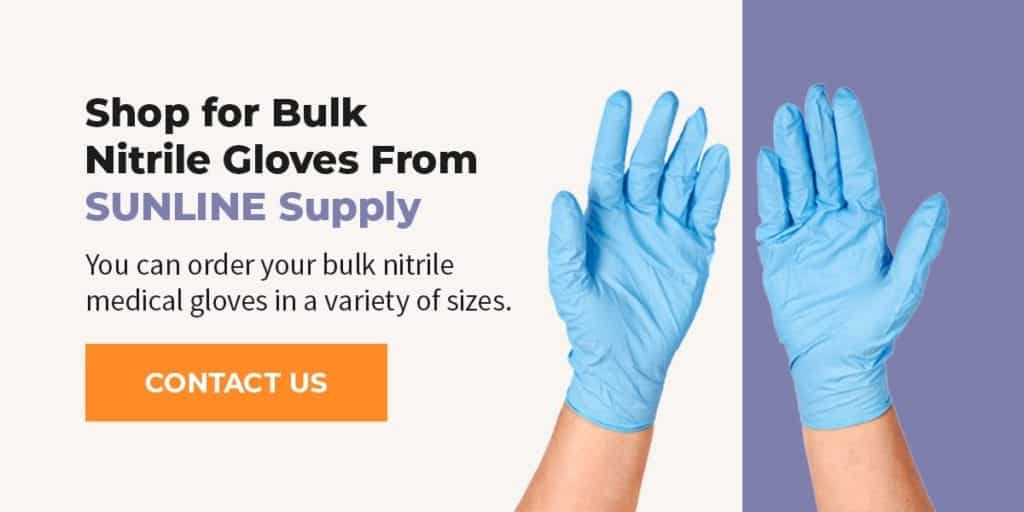
Want to Learn More? Check out These Additional Posts
-
How Is PPE Tested? Standards, Performance and Examinations
Personal protective equipment (PPE) is gear individuals wear to protect themselves from illness or injury on the job. PPE includes objects such as masks, gloves, face shields and gowns, which create a barrier between the person wearing them and hazardous materials or infectious agents. Employees working in the health care, construction, food and drink, education…
-
Sterile vs. Non-Sterile Gloves: What to Know Before Your Purchase
If you must source disposable gloves for your organization, be it a healthcare facility or production plant, you have many options to consider. You might need to determine whether to order nitrile, vinyl or thermoplastic elastomer (TPE) gloves alongside figuring out the correct quantities. Non-sterile gloves have many applications outside of clinical use, in everything…
-
Buying the Right Type of Medical Glove: 10 Things to Consider
Medical-grade gloves are a vital piece of personal protective equipment (PPE) for many professional environments. Though most often used in healthcare settings, disposable medical gloves are also necessary for caregivers, food handlers, dentists and other professionals. Wherever health and sanitation are top concerns, protective gloves are essential. They help stop the spread of germs and…


ThxToms gloves are exactly what I needed! I work with a variety of corrosive acids, and these gloves are definitely doing what they are supposed to! They are holding up to the acids I use, with no sign of wear, tear, or puncture! Chemical resistant. Can use these whenever you need to protect your hands/skin.